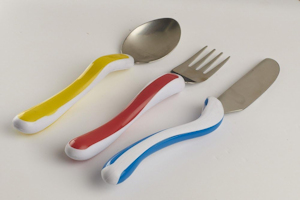Cutlery
 Using cutlery involves lots of skills so here are some tips on how to progress from using hands, to single cutlery to then using both a knife and fork at mealtimes.
Using cutlery involves lots of skills so here are some tips on how to progress from using hands, to single cutlery to then using both a knife and fork at mealtimes.Spoon
Play games and activities to help develop skills for feeding with a spoon
- playing in water/sand scooping and pouring.
- cooking/baking - holding a bowl while mixing with a spoon or spooning the mixture out of bowl.
- get the young person to associate the spoon with eating by giving one to hold while adult feeds with another spoon.
- make sure the young person is motivated to eat the particular food given.
- ensure the non-feeding arm is supporting the bowl.
Fork
- When your child is holding a fork initially use a plastic bowl, and then progress to using a plate. The bowl is useful to assist young people to load food onto fork using the sides.
- Use foods that are easier to hold on the fork e.g. chicken and cooked carrots, avoid foods that will fall apart easily e.g. mashed potato and hamburgers.
Knife
Practice first without fork.
- It is usually easier to use the fork in your non-dominant “helper” hand and your knife in your dominant "worker" hand.
- Encourage a good cutlery grasp right from the start; index “pointer” finger should point down the back of the knife and fork towards the blade and prongs. You can put a sticker or a dot of nail varnish to show where their index finger should go.
- They may benefit from prompting to 'stab' food with the fork to keep it in place, and to 'cut, back and forth.'
Graded approach: Start with soft foods then onto firmer foods
- Soft: scrambled eggs, bananas, potato chips.
- Medium: pepper/cucumber sticks, pieces of apple, sausages, cheddar cheese sticks.
- Hard: carrot sticks, potato stick, Original Pepperami stick, celery sticks.
- Practice with foods such as sausages and fish fingers that are longer so easier to cut.
Mealtime tips
Make sure your young person can comfortably sit at the table:
- Can their feet touch the floor?
- Is their bottom resting at the back of the seat?
- Can their elbow rest comfortably on top of the table?
- Use non-slip matting under the bowl or use a suction bowl on the table to help keep it still.
- Use a plate with a raised edge to prevent the food from sliding off the plate.
- Cutlery that has a thicker handle is easier to grasp, and may be beneficial when learning e.g. caring cutlery.
Last updated10 Oct 2025

